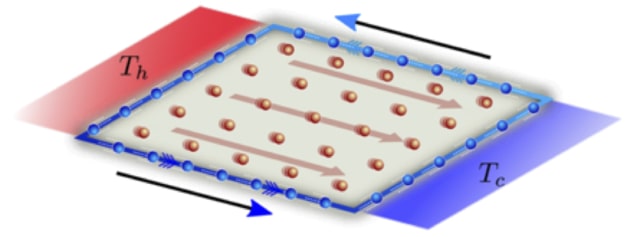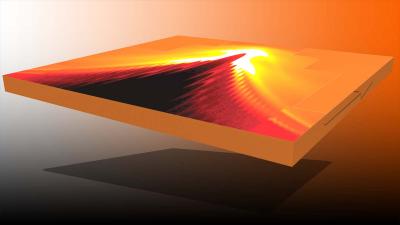
Can energy move from a colder to a hotter region in a material without violating the second law of thermodynamics? Yes, according to physicists from Trinity College Dublin and the Universidad Complutense of Madrid, who discovered that a quantum effect sometimes forces current to flow around the edges of a sample in a way that opposes the normal direction of heat flow. These “edge currents” are remarkably robust, and the physicists say they could be present in a broader class of range of systems than previously thought. If that is the case, such currents might be used to control heat flow through nanostructures and thus help bring about more energy-efficient computer chips or devices to recycle waste heat.
Edge currents occur in so-called topological materials, which are materials whose surface properties are very different to those found in their bulk. They are named after topology – the “rubber sheet geometry” branch of mathematics in which two objects are assumed to be equivalent, or trivial, if they can be continuously deformed into one another by bending, twisting, stretching or shrinking (but not tearing or cutting). In this framework, a circle is topologically equivalent to an ellipse, and a doughnut equivalent to a coffee mug, because these pairs of objects can be deformed into each other by stretching. In contrast, a doughnut cannot be deformed into a ball without ripping it apart because of the hole at its centre. This is an example of “non-trivial” topology.
Topological materials show similar geometries on the molecular scale in their energy spectrum, instead of in physical space. This gives rise to several unusual mechanical and electrical properties. Topological insulators, for example, do not carry electrical currents in their bulk, but current does flow along their surfaces through special “edge” states. The electrons in these states can only travel in one direction, and they also steer around imperfections or defects on the surface without backscattering. Since backscattering is the main energy-dissipating process in electronic devices, these “topologically protected states”, as they are known, might be useful ingredients in next-generation energy-efficient devices.
The “erasure” effect
While researchers have known for decades that robust edge currents exist in topologically non-trivial systems, team member Mark Mitchison of Trinity College’s School of Physics says they did not expect to observe such currents in topologically trivial ones. He and his colleagues discovered that the counterintuitive currents appear if the system is subject to a temperature gradient – that is, if one end is hotter than the other. In their work, they achieved this by coupling each end of a hypothetical sample with so-called quantum Hall bar geometry to two thermal reservoirs at different temperatures and simulating what happened using a computer model. The quantum Hall bar is routinely used in experiments and consists of a two-dimensional electron gas (a scientific model used in solid-state physics) that is contacted by six electrodes. This set-up can be used to measure the transport characteristics of the gas.
“To our surprise, we found that edge currents remain stable, implying that one of them runs against the natural direction of heat flow,” says team member Angel Rivas.
To shed more light on this puzzle – and why it doesn’t go against the second law of thermodynamics – the physicists next considered a more general model that supports two very different phases: a topological insulator phase and a “trivial” band insulator phase. They found that while the current flows in the opposite direction to their expectations on the edge, the overall net transfer of heat is always from the hot to the cold reservoir, meaning that the second law of thermodynamics is never violated.
“We explain this by the ‘erasure’ effect,” team member Miguel Angel Martin-Delgado tells Physics World. “Here, circulating currents cancel out in the bulk but add constructively on the edge, giving rise to the counterintuitive current patterns that we observed.”
Heat management applications
While the Dublin-Madrid team focused on a particular theoretical model, members say the phenomenon is general and could in principle arise in a broad class of materials. Rivas notes that although the team’s results are theoretical, he expects the findings could eventually be useful for controlling heat through small structures. “Heat management at the nanoscale has many useful applications: for example, the design of more energy-efficient computer chips or devices to recycle waste heat,” he says.

Supercurrent goes to the edge
The researchers say they will now study other geometries beyond 2D structures. “We have already shown in a recent preprint that crosscurrents can exist in 3D systems, meaning that the current flows from cold to hot throughout an entire 2D surface, instead of just along a 1D line,” explains Martin-Delgado. “But we can even think further and speculate about higher dimensions – for example; a 4D cube which would have a 3D cube as one of its boundaries. Thus, the Second Law could be apparently violated in a 3D world that is the boundary of a 4D system.”
This may sound unrealistic, he admits, but such systems have already been realized in the laboratory using quantum simulators engineered to have “synthetic dimensions”. “Working out how our results could be experimentally implemented in such simulators is another major goal for our future research,” he concludes.
The present study is detailed in Physical Review Letters.
